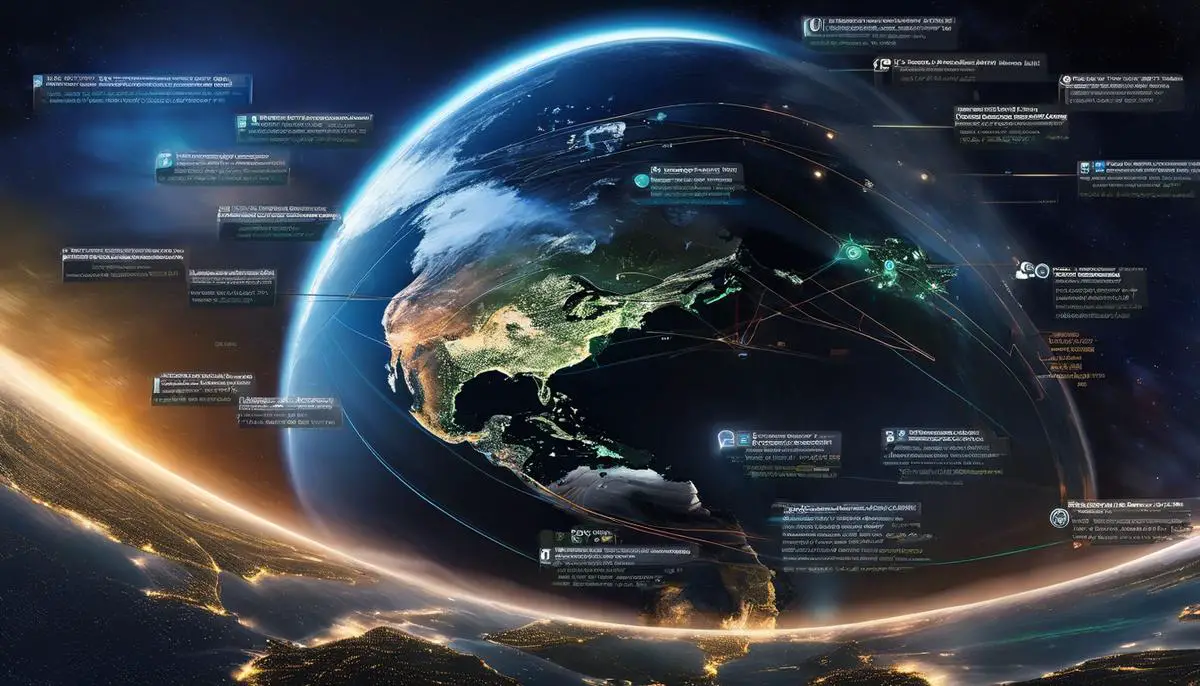In the rapidly evolving landscape of today’s digital communication, a notable technological marvel that stands out is satellite communication systems. Encapsulated in their spacely orbits lie not just artistic feats of human ingenuity but also pivotal tools that facilitate a myriad of critical functions, from military operations and global broadcasting to disaster management and global positioning. As we tread further into this technological wonder, it is critical to fully grasp the intricacies of its operation, potential vulnerabilities, and the dire implications of the cyber threats they face. Having a comprehensive understanding of the satellite communication infrastructure, including its unique components such as the satellite, the ground station, and the user terminal, is the first step in this journey.
Understanding Satellite Communication Systems
Unique Features and Functionalities of Satellite Communication Systems: A Detailed Assessment
Satellite communication systems have long been heralded as the epitome of technological advancement, providing a level of connectivity that was previously unthinkable. They possess unique features and functionalities that distinguish them from other communication systems, fostering efficient data transmission on a global scale. This article aims to elucidate these distinguishing characteristics that underpin the inestimable value of satellite communication systems.
One of the most crucial features of satellite technology is the extensive geographical coverage it offers. Unlike other modes of communication that are restricted by terrestrial limitations, satellite communication systems can reach even the most remote corners of the world. Thus, these systems provide an invaluable service in areas where no other form of communication is feasible, such as in remote rural regions, inaccessible mountainous areas, and widespread oceans.
Adding to this breadth of coverage is the system’s remarkable ability to simultaneously broadcast to multiple locations. This feature, known as multipoint distribution, is pivotal in the broadcasting industry, making it possible to disseminate radio and television programming to numerous stations at once—which terrestrial systems can struggle to achieve. This ability to engage a widespread audience demonstrates the power and potential of satellite communication systems.
Another distinguishing characteristic is the high reliability of satellite communication systems. With satellites orbiting the earth in the stability of space, there is little risk of physical damage or system interruptions due to earthly calamities. This predictability lends providers and users high levels of confidence in the robust and consistent performance of these systems in providing uninterrupted connectivity.
Furthermore, satellite communication systems excel in capacity expansion capabilities, representing an easily scalable solution. Adding new users or expanding coverage is achieved without significant infrastructure changes, as in cable or telephone systems. This scalability, coupled with cost-efficiency, makes satellite communications advantageous for commercial, civic, and disaster response applications.
Lastly, the comprehensive data transfer capabilities of satellite communication systems cannot be overlooked. These systems support a broad spectrum of data types including text, audio, video, and even complex satellite imagery, offering diverse applications in fields such as meteorology, telemedicine, military intelligence, and telecommunications.
However, while lauding the uniqueness and superiority of satellite communication systems, it is crucial to acknowledge the persisting challenges. These include susceptibility to signal interference, latency issues, and the need for line-of-sight operations, demanding a balanced viewpoint on the use and pursuance of this technology.
Every challenge elucidated, every unique feature underscored, serves to further incite the pursuit of excellence ingrained in the fabric of scientific exploration. The unique features and functionalities of satellite communication systems underline their irreplaceable role in shaping our interconnected world—a testament to the unfathomable possibilities harbored at the interplay of science, technology, and human determination.

Identifying Cybersecurity Vulnerabilities in Satellite Communication Systems
Unmasking the Digital Achilles’ Heel: Cybersecurity Shortcomings in Satellite Communication Systems
Satellite communication systems are modern marvels, streamlining connectivity over vast distances, making our world feel smaller and our frontiers less daunting. Yet, as we relentlessly march towards a globally connected era, these systems—the very cerebral cortex of our digital civilization—expose us to a spectrum of cybersecurity vulnerabilities.
One glaring weakness steers clear as the susceptibility of satellite systems to malicious intrusions, courtesy of their inherently open and shared medium. Unlike the tight-knit, secure architecture in terrestrial communications, satellites’ broad-spectrum signals covering extensive geographical areas can be effortlessly intercepted by adversaries. The villainy of nefarious elements, employing off-the-shelf satellite reception equipment or exploiting various software vulnerabilities, can encroach upon these systems, leaving a trail of undesirable consequences in their wake.
Moreover, security protocols applied within these systems are, at times, woefully insufficient. Encryption standards in satellite communication systems often flit below 128-bit, with some commercial satellites still operating on unencrypted data channels. This inadequate encryption exposes sensitive assets to siphoning and tampering scenarios, breeding a veritable hotspot for cyber espionage.
Addressing the physical aging of satellites, we cannot miss the stature of the issue. Technologies in orbit, hard-coded with older security protocols, software, and hardware components, cannot be updated or patched as regularly as terrestrial systems. This delay in updates and system modifications thus hands over digital longevity to potential attackers.
Then creeps in the complexity of ‘jamming’ and ‘spoofing,’ slick double agents in our narrative of cybersecurity shortcomings. Jamming – the deliberate interference with the communication frequency of a satellite, can play havoc with data integrity while spoofing – the act of masquerading as a legitimate device can misdirect entire communication processes. These acts push the integrity of the systems to the brink and steer the path for prolonged system and service outages.
Finally, the lack of universal standards and formal regulatory structures in the realm of space cyber law presents a quandary when addressing these cyber threats. Discrepancies in international jurisdiction, legal procedures, and norms have led to ample confusion and ambiguity on response mechanisms, accountability, and culpability. This lack of clear oversight and unification magnifies the task of reinforcing satellite communication system security.
These are not hypothetical scenarios, but real and increasing quandaries that could irrevocably torpedo the safety of our digital globe. Remediating these shortcomings through fortifying cyber-secure frameworks and robust, universally acceptable cyber laws can mitigate the threat landscape, ensuring the inviolability of satellite communications. The digital arms race has begun; it is time to arm ourselves better.

Profiling Common Cyber Threats to Satellite Communication Systems
In continuing this intriguing exploration of satellite communication systems, it is crucial to delve deeper into the analysis of the specific types of cyber attacks these systems commonly face. A comprehensive understanding of the nature and method of these attacks could lead to innovative countermeasures, ultimately enhancing the security of these essential communication instruments.
Notably, DDoS (Distributed Denial of Service) attacks are one of the most pervasive threats to satellite communication networks. These attacks flood systems with redundant requests or messages, overloading their processing capacity and leading to an inability to perform legitimate operations, a phenomenon somewhat similar to peak road traffic obstruction.
Another significant type of cyber attack on satellite communication systems involves the exploitation of system vulnerabilities through malicious software, colloquially known as malware. This includes worms, viruses, trojans, and ransomware, which infiltrate the network system and cause extensive damage either immediately or over a period, based on their programming directives.
A third substantial category includes eavesdropping and intercepting attacks. In these cases, perpetrators clandestinely monitor or intercept communication between satellites and ground stations, known as “man-in-the-middle” attacks. These attacks lead to the unauthorized acquisition of sensitive data, which can lead to additional breaches, such as identity theft or systemic encryption key exposure.
On the physical end of the cyber-heist spectrum are radio frequency (RF) attacks wherein malicious actors attempt to manipulate the satellite’s operability by transmitting harmful signals. These can take the form of either uplink or downlink signal disruptions, with the objective of causing interference, inhibiting communication, manipulating data, or completely disabling the satellite.
Another method gaining popularity in the audacious art of satellite cyber attacks is Side-channel attacks. Unlike direct attacks, these exploit indirect information such as timing data, power consumption, or electromagnetic leaks. Such exploitation usually requires sophisticated knowledge and equipment, yet the availability of such resources in the contemporary world cannot be ignored.
Lastly, a notable mention should be given to Advanced Persistent Threats (APT), which pose an acute risk to satellite communication systems. APT attacks, typically state-sponsored, are stealthy and continuous hacking processes that aim to siphon off high-value information over extended periods.
In summary, while the magic of satellite communications is undeniably an asset in the modern world, it cannot be forgotten that these systems are susceptible to various targeted cyber attacks. Therefore, the quest for stronger cybersecurity must be continually pursued to protect these satellites’ invaluable service. From DDoS flooding and malware infections to RF interferences and APT threats, the cyber battlefield is replete with potential risks, underscoring the urgent demand for fortified cyber security and rigorous legal frameworks in the realm of satellite communication.

Approaches to Cybersecurity in Satellite Communication Systems
In the realm of measures undertaken to strengthen the cybersecurity of satellite communication systems, it’s evident that there is blossoming innovation across the spectrum. Recognizing the vulnerabilities and perpetually evolving threats these systems face, industry experts, academia, and governments are collaborating to implement new security strategies.
One of the most crucial strategies being adopted currently is the development of advanced encryption algorithms. These algorithms offer a more significant level of protection than traditional methods, rendering an attacker’s task much more arduous. Advanced Quantum Cryptography is an example of an algorithm where the principle of quantum physics is leveraged to encrypt messages. Any attempt to intercept the encrypted message leads to an irreversible change in the quantum state, rendering it useless.
Similarly, machine learning and AI techniques are progressively harnessed to identify and counteract threats. By detecting unusual patterns in the communication flow or identifying markers of attempted breaches, these systems can launch a swift defense or alert human operators.
Frequent security audits and vulnerability assessments form another core strategy. By continually scrutinizing current security measures and identifying potential weak spots, rectifying action can be taken timely, effectively mitigating the risk of a breach. Penetration testing, a subset of security audits, challenges the existing security layers by simulating cyberattacks.
Another pivotal strategy is the introduction of robust authentication protocols. Increasingly, biometric authentication technologies, cryptographic protocols, or a combination of both are adopted to ensure the user’s identity in highly sensitive and critical communication channels.
Regarding physical security, tamper-resistant satellite designs are being looked into. These would ensure that critical components of the satellite system are inaccessible and immune to common physical attack vectors.
Forming international coalitions and agreements to enforce well-defined cyber laws in outer space is gaining momentum. This global, collective effort is essential to keep malevolent actors in check and hinder the exploitation of universal resources like space for personal gain or causing significant disruption.
Besides, to address the persistent risk of Advanced Persistent Threats (APT), constant monitoring, incident response improvements, and conducting regular cyber hygiene checks are adopted for breaching mitigations. The use of firewall advancements and intrusion detection and prevention systems is also prevalent in the current cybersecurity landscape.
Although these strategies and measures present significant strides in the quest for secure satellite communications, it’s important to remember that cybersecurity is a dynamic, ever-evolving field. Maintaining pace with potential attackers’ advancements is imperative, thereby warranting continuous innovation and adaptive strategies in maintaining the safety of our satellite communication networks.
Getting it right isn’t an option – it’s an absolute necessity. As we continue to push the boundaries of human understanding and capability, how we secure our communication in space will become progressively more intertwined with how we live and function on Earth. The quest is not for superiority, but survival and sustainability in an increasingly connected and automated world.

Future Directions in Enhancing Cybersecurity in Satellite Communication Systems
As the realm of cyberspace ceaselessly progresses, the conversation naturally turns to discussing potential future enhancements that could dramatically augment the cybersecurity of satellite communication systems. Such improvements are critical in a world where space is no longer the final frontier but a terrain increasingly trod by an array of interconnected technologies seeking reliable, secure communication.
One current avenue of exploration is the introduction of decentralized, blockchain-based security approaches. Originating from cryptocurrency technology, blockchain’s resilience against data tampering makes it a promising candidate for secure satellite communication. A transparent, universally accessible ledger of all communication transactions and unique cryptographic sequences (hashes) could afford unprecedented security, deterring threats such as eavesdropping and interception.
Parallelly, nanotechnology, too, holds significant promise. When adapted to cybersecurity protocols, nanotechnology could aid in the development of miniature, energy-efficient security components without compromising their efficacy. Nano-based mechanical and electronic systems adapted into satellites could play an instrumental role in building more proficient and compact surveillance systems or sophisticated encryption mechanisms.
The assimilation of bioinformatics with cybersecurity is another frontier being explored. By using algorithms mimicking biological processes such as DNA transcription and sequence generation, we might develop unique codes that can confound even the most experienced of hackers. This hybridization could result in ultra-secure encryption standards and a new era of biological-based cryptographic systems.
Honeytrap security measures could also be the strategic answer against Advanced Persistent Threats (APTs). Similar to how a beekeeper uses a honey pot to distract bees from the hives, digital honey pots and honeynets could be configured to attract and divert APTs. Duped by the dummy targets, malicious intruders would essentially waste their resources and reveal their strategies while the real assets remain secure.
Furthermore, the implementation of Reactive Security Technologies (RSTs) to detect and respond to abnormal behaviors can create a self-defending network. Drawing from elements of machine learning and artificial intelligence (AI), RSTs can adapt and evolve over time, learning from previous threats and preemptively strengthening against future potential attacks.
The advent of quantum key distribution (QKD) is also set to revolutionize secure communication. By utilizing the principles of quantum mechanics, QKD would help establish highly secure key agreements suitable for virtually uncrackable communication systems, thus significantly improving the security of satellite communication systems.
Finally, advancements in 5G and future 6G technology present themselves as both a challenge and an opportunity. While the proliferation of high-speed communication has inherent vulnerabilities, adopting secure, 5G-enabled satellite communication infrastructure could help in creating a “network of networks,” forming a comprehensive, concentrated cyberspace command with superior protective potential.
These are but a few masterpiece cogs in the expansive and dynamic clockwork of potential cybersecurity enhancements for satellite communication systems. The artistry lies within the intersection of these multiple disciplines, converging towards a consilience – a unifying resolution to the challenges we face in the far reaches of cyberspace, infinitely expanding, demanding our utmost vigilance and ingenuity.

The advent of satellite communication systems heralded a new era in global connectivity and opened Pandora’s box of cybersecurity challenges. As we edge into the future, it is incumbent upon us to continuously gauge and counteract evolving cyber threats, thereby ensuring the integrity of this vital communication channel. This not only involves advancing defensive technologies but also instilling a culture and paradigm shift in how cybersecurity is perceived and approached in relation to satellite communication systems. As we undertake this monumental task, we are not just securing our current communication; we’re actively safeguarding the future as well.